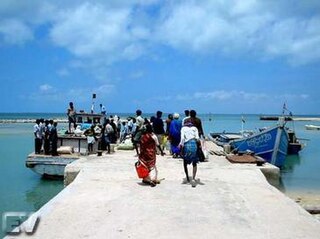
The Truth and Reconciliation Commission (TRC) was a court-like restorative justice body assembled in South Africa in 1996 after the end of apartheid. Authorised by Nelson Mandela and chaired by Desmond Tutu, the commission invited witnesses who were identified as victims of gross human rights violations to give statements about their experiences, and selected some for public hearings. Perpetrators of violence could also give testimony and request amnesty from both civil and criminal prosecution.

The Liberians United for Reconciliation and Democracy (LURD) was a rebel group in Liberia that was active from 1999 until the resignation of Charles Taylor ended the Second Liberian Civil War in 2003. While the group formally dissolved after the war, the interpersonal linkages of the civil war era remain a key force in internal Liberian politics.
The Rais massacre, of August 28, 1997, was one of Algeria's bloodiest massacres of the 1990s. It took place at the village of Rais, near Sidi Moussa and south of Algiers. The initial official death toll was 98 people killed and 120 wounded; CNN said that hospital workers and witnesses gave a toll of at least 200, and up to 400. The figure given by the Algerian government to the UN Commission on Human Rights was 238. The BBC later quoted the figure of 800 killed.

The Azanian People's Liberation Army (APLA), formerly known as Poqo, was the military wing of the Pan Africanist Congress, an African nationalist movement in South Africa. In the Xhosa language, the word 'Poqo' means 'pure'.
The Saint James Church massacre was a massacre perpetrated on St James Church of England in South Africa in Kenilworth, Cape Town, South Africa, on 25 July 1993 by four members of the Azanian People's Liberation Army (APLA). Eleven members of the congregation were killed and 58 wounded. In 1998 the attackers were granted amnesty for their acts by the Truth and Reconciliation Commission.

In My Country is a 2004 drama film directed by John Boorman, and starring Samuel L. Jackson and Juliette Binoche. It is centred around the story of Afrikaner poet Anna Malan (Binoche) and an American journalist, Langston Whitfield (Jackson), sent to South Africa to report about the South African Truth and Reconciliation Commission hearings.

The Church Street bombing was a terrorist car bomb attack on 20 May 1983 in the South African capital Pretoria by uMkhonto we Sizwe (MK), the paramilitary wing of the African National Congress. The bombing killed 19 people, including the two perpetrators, and wounded 217.

The Kumudini or Kumuthini boat massacre happened on 15 May 1985, when at least 23 minority Sri Lankan Tamil adults and children on a ferry boat named Kumudini sailing from the island of Delft to the island of Nainathivu were killed by Sri Lankan Navy personnel.

The Liberian Truth and Reconciliation Commission (TRC) is a Parliament-enacted organization created in May 2005 under the Transitional Government. The Commission worked throughout the first mandate of Ellen Johnson Sirleaf after she was elected President of Liberia in November 2005. The Liberian TRC came to a conclusion in 2010, filing a final report and recommending relevant actions by national authorities to ensure responsibility and reparations.

The Truth and Reconciliation Commission of Canada was a truth and reconciliation commission active in Canada from 2008 to 2015, organized by the parties of the Indian Residential Schools Settlement Agreement.

The No Gun Ri massacre was a mass killing of South Korean refugees by U.S. military air and ground fire near the village of Nogeun-ri (노근리) in central South Korea between July 26 and 29, 1950, early in the Korean War. In 2005, a South Korean government inquest certified the names of 163 dead or missing and 55 wounded, and added that many other victims' names were not reported. The No Gun Ri Peace Foundation estimates 250–300 were killed, mostly women and children.
The Commission of Inquiry to Locate the Persons Disappeared during the Panchayat Period (1990–1991) is a truth commission established in Nepal in 1990 after the end of the autocratic Panchayat Regime by the first post-Panchayat Prime Minister Krishna Prasad Bhattharai. The commission was set up to examine allegations of human rights violations and inquire about enforced disappearances during the Panchayat system from 1961 to 1990. A report was officially submitted to the government in 1991, but it was made public only in 1994. The commission identified 35 persons disappeared on about one hundred studied cases. However, no alleged perpetrators were judged.
The Johannesburg Magistrate's Court Bombing took place on 20 May 1987 in Johannesburg, in the former Transvaal Province, now in Gauteng. The bombing is often referred to as a massacre in which 4 South African Police members died and a further 15 civilians were injured. It was perpetrated by the ANC's Umkhonto we Sizwe (MK) para-military wing.

The Amanzimtoti bombing took place on 23 December 1985 when five civilians were killed and 40 were injured when Andrew Sibusiso Zondo, a member of uMkhonto we Sizwe, detonated an explosive in a rubbish bin at a shopping centre.

Peru's Truth and Reconciliation Commission was a truth and reconciliation commission established by President Alejandro Toledo to investigate the human rights abuses committed during the internal conflict in Peru between 1980s and 1990s. The TRC was a response to the violent internal conflict between 1980 and 2000 during the administration of Presidents Fernando Belaúnde (1980–1985), Alan García (1985–1990), and Alberto Fujimori (1990–2000). The commission's mandate was to provide a record of human rights and international humanitarian law violations committed in Peru between May 1980 and November 2000, as well as recommend mechanisms to promote and strengthen human rights. The TRC reported on the estimated 70 000 deaths, assassinations, torture, disappearances, displacement, employment of terrorist methods and other human rights violations executed by the State, Shining Path, and the Túpac Amaru Revolutionary Movement. The report concluded that there is both institutional and individual accountability, as well as identifying racial and cultural factors that became a catalyst for conflict.
The Monrovia Church massacre, also referred to as the St. Peter's Lutheran Church massacre, was the worst single atrocity of the First Liberian Civil War. Approximately 600 people were killed at the church, on 14th Street, in the Sinkor district of Monrovia on 29 July 1990. The massacre was carried out by approximately 30 government soldiers loyal to President Samuel Doe. The perpetrators were of Doe's Krahn tribe while most of the victims were from the Gio and Mano tribes, which were in support of the rebels.

The Executive Mansion of Liberia is the official residence and workplace of the country's president. Located across the street from the Capitol Building in the Capitol Hill district of Monrovia, the current building was constructed during the presidency of William Tubman, which lasted from 1944 to 1971. The construction started in 1961, and was completed in 1964.
Maher: Black Rain in Bomi is a 2016 Liberian film based on the testimonies of survivors of a 2002 massacre in Bomi County. Directed by the video journalist Derick Snyder, it was shown at the Fighting Stigma Through Film festival in London in 2018.

The Mai Kadra massacre was a massacre and ethnic cleansing carried out during the Tigray War on 9–10 November 2020 in the town of Mai Kadra in Welkait in northwestern Ethiopia, near the Sudanese border. Responsibility was attributed to a pro-TPLF youth group and forces loyal to the Tigray People's Liberation Front (TPLF) in the EHRC-OHCHR Tigray Investigation, preliminary investigations by Amnesty International, the Ethiopian Human Rights Commission (EHRC) and the Ethiopian Human Rights Council (EHRCO), and interviews conducted in Mai Kadra by Agence France-Presse. The Office of the United Nations High Commissioner for Human Rights (OHCHR) and EHRC reported that at least 5 Tigrayans were killed in Mai Kadra by Amhara militas such as Fano in retaliation. Tigrayan refugees in Sudan told multiple news outlets that Tigrayans in Mai Kadra were targeted by either Amhara militias, the Ethiopian National Defense Force (ENDF), or both.

The Axum massacre was a massacre of about 100–800 civilians that took place in Axum during the Tigray War. The main part of the massacre occurred on the afternoon and evening of 28 November 2020, continuing on 29 November, with smaller numbers of extrajudicial killings taking place earlier, starting from 19 November and during the weeks following the 28–29 November weekend. The massacre was attributed to the Eritrean Defence Forces (EDF) by Amnesty International, Associated Press, the Ethiopian Human Rights Commission (EHRC), Human Rights Watch (HRW) and Adigrat University lecturer Getu Mak.














